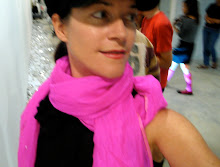Since coming to Singapore, and being back in the diverse and rich festival worlds of south east Asia and greater Asia, I've been on site researching and recording as much as possible. From August 13th (arrival) to 24th (departure), 2008. I was invited to join From Ritual to Theatre – Asian Ritual Festival Workshop, organized by OISTAT Secretariat and supported by Taiwanese Governments. The workshop took place during the Ghost Festival in Taiwan.The opportunity to work with theater people was a first, and housed within this the focus on ritual was extraordinarily ideal.
As one of the international artists, I was asked to present my work in order to be invited, and again, on the second day of the workshop, to the participants. The response to my own work was positive (being a visual communication I was nervous that my work would be too left field). But the live art and the intersection of performance with graphic design history, and my body of work in staging and documenting live art experiences, somehow connected well with the participants who were enthusiastic to collaborate They compared my most recent grant work at Taishan to Christo.

The workshop consisted of a two-day trip to visit the Ghost Festival ceremony in Keelung to observe the Taoist Shaman’s ritual performance, lantern pole erection, folk art parades and the “ water lantern releasing to the sea”. We also were guided through rituals like the “Grand Putu” as well as the Hakka Holy Boar Competition. In the workshop we were expected to share our observations and inspiration with the Taiwanese performing art professionals (directors, designers), as well as theatre apprentices/assistants who toured and worked with us. The intention of the workshop was to encourage intercultural exchange and dialogues based on the grass-roots culture and to transform the ritual into theatrical ideas.
 Hakka Holy Boar Winner 2008
Hakka Holy Boar Winner 2008a boar, fed like a king for a year, then stretched out and painted and displayed for competition
It was expected that after breaking into smaller groups during the workshop, that we work intensively together in the conceptualization, making and staging of our projects on the final day of the workshop in the form of installations, story boards for a potential production, video/photo documentary and its transformation, design as performance, etc. My group consisted of one of the leading choreographers of Taiwan, Hsiao-Mei Ho—leader of Taipei Crossover Dance Company and Associate Professor of Dance Department of TNUA—and her four dance students, as well as Francis Shen—one of the top costume designers and also one of his students. We worked intensively and were able to bring our areas of interest together into a performance on the last night.
My contribution was in the concept, the space, the stage design and the experience of the audience. I also staged a ritual using the paper money for the ghosts, which ended up becoming the floor for the audience. For an entire day i layout the papers one by one, into a perfect mandala like shape. It was exhausting. but somehow the absurdity of what i was doing (i had no idea what i was doing until i began and then i was too stubborn to quit) attracted the attention of nearly everyone, and the combination of these papers, the possible presence of ghosts, and my obstinacy in finishing it completely made the entire process elevate on it's own.
There is only one step from the sublime to the ridiculous.Somehow within this collaboration i was able to stay true to my own research and interests while working with 2 strong directors. It was incredibly satisfying.
— Napoleon Bonaparte
The response to our collaboration was very positive and we are in the process of exploring how to make this into an actual performance in both Taiwan and Singapore. Hsiao-Mei Ho is looking into funding in Taiwan. Further development of works from the workshop has been strongly encouraged and OISTAT is hoping the works may be presented in future OISTAT events such as Scenofest, World Stage Design, or even end up as production in Taiwan.
 |




No comments:
Post a Comment